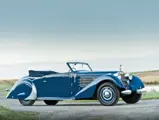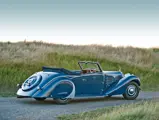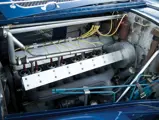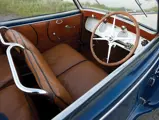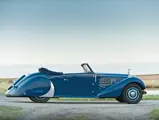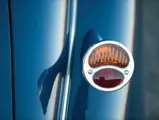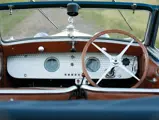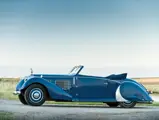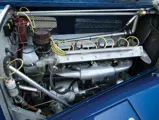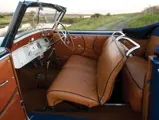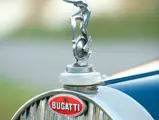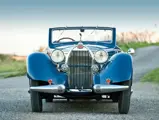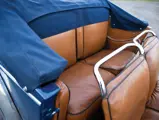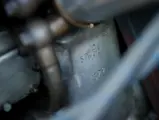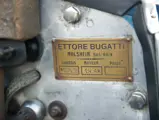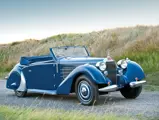London 2011
1937 Bugatti Type 57 Stelvio Cabriolet by Gangloff
{{lr.item.text}}
£296,800 GBP | Sold
 | London, United Kingdom
| London, United Kingdom
{{internetCurrentBid}}
{{internetTimeLeft}}

135 hp, 3,257 cc DOHC inline eight-cylinder engine, four-speed manual gearbox, solid front axle with semi-elliptic leaf springs, live rear axle with quarter-elliptic leaf springs, and four-wheel mechanical brakes. Wheelbase: 3,300 mm
• The ultimate pre-war Bugatti road car
• Sophisticated design and legendary engineering
• Offered complete with EU paperwork
The Type 57 is perhaps the most celebrated of all road-going Bugatti chassis, with a rare combination of style and performance that made it an instant success and marked the final and most enduring automotive legacy of Jean Bugatti, one of the sons of Le Patron, Ettore Bugatti. To be successful, Bugatti’s new model of course had to be both powerful and beautiful, and it was expected to appeal to the company’s discerning and elite clientele, skilfully exhibiting the Molsheim firm’s renowned design and engineering prowess. The development of the Type 57, in many ways, reflected both the maturation of the Bugatti marque and that of Jean Bugatti himself, who was allowed to develop the model with minimal influence from his father.
Introduced in 1934, the Type 57 quickly proved itself everything it was expected to be. Not only was the chassis clearly Bugatti, but the new engine provided more power with less noise and reduced vibration, as well as improved reliability and durability. It retained Bugatti’s signature double overhead-camshaft valvetrain, but the cam was now gear-driven at the rear of the engine block. Rated at 135 bhp in normally aspirated form, the new 3.3-litre engine was fitted with a conventional clutch and gearbox.
Several catalogued body styles were offered, but the most popular open car was the dashing Stelvio four-seat cabriolet. Penned by Jean Bugatti himself, the bodies were built by several of the finest coachbuilders of the era, most notably Gangloff, with slight variations over the years. Today, the Type 57 is recognised as being the most sporting of all non-racing Bugattis, and between its debut for 1934 and the outbreak of WWII, more than 680 examples are estimated to have been produced. Notably, the dashing and sophisticated Stelvio Cabriolet was offered throughout the entire production run of the Type 57.
The body constructor of the Stelvio offered here, Gangloff, was founded in 1903 by Georges Gangloff and headquartered in Bern, Switzerland from 1928. The company operated several branches during the pre-war era, including Geneva, Zurich, Bern and Colmar in France, and it was a major supplier of bodies for Bugatti.
CHASSIS 57435
The example from 1937 offered here, chassis no. 57435, is fitted with engine number 322 and Stelvio open coachwork. Invoiced new on 11 June, 1937 to one Mr. Peigues Seligmann, who was a Bugatti agent in France, records indicate this car was in fact used as Mr. Seligmann’s demonstration car. Interestingly, the body for 57435 was the first unit built by Gangloff employee Mr. Slatter after his promotion to “work master.” In 1937, the maroon coachwork was priced at more than 18,450 French Francs—a small fortune at the time.
The next historical record we have of 57435 is of its sale to Auguste Lis of Strasbourg, who in turn sold the car in 1960 to one J.A. Veldkamp of Groningen, Holland. J.D. Legger of England purchased the car in 1967 and had it repainted in British Racing Green with an Apple Green interior. Thereafter, the car is believed to have remained for some 30 years in England prior to being exported in 1999 to a collector in Germany. He laid the car up in 2000, and since that time, it was sold to Switzerland and acquired more recently by the vendor.
Complete with EU paperwork, the Stelvio remains in excellent overall condition throughout. The bodywork shows signs of a highly skilled restoration at some point in the car’s history, complete with an older re-trim in the correct light tan hides, along with a new hood and hood cover. All the period details are correct, including the radiator mascot and the rear light clusters.
In many ways, it could be said that, like the Ventoux, the Stelvio was an evolution of the line that began with the T50 Profile in 1930 and was simply more refined, lower, sleeker and, as a consequence, that much more elegant. The result was that the Stelvio caused a sensation in the prestigious concours events of the era, and with its ample power output, remarkable technical sophistication and sophisticated driving dynamics, it proved equally attractive to performance-hungry pre-war drivers. Little has changed in more than seven decades as this Stelvio represents perhaps the pinnacle of pre-war French automotive design and engineering.

